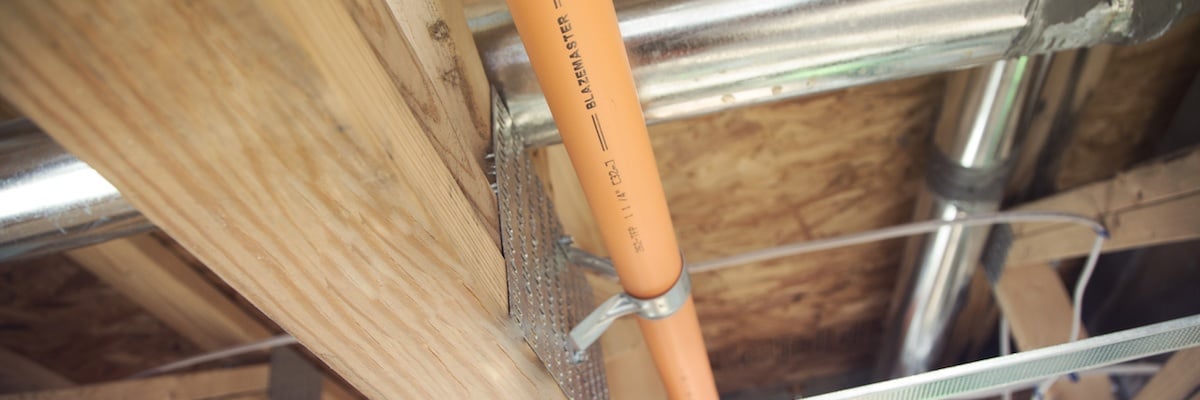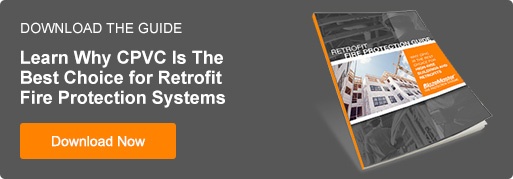American Fire Systems Builds Firestopping Business With BlazeMaster® CPVC Pipe
It wasn’t that many years ago that codes first started mandating the practice of firestopping in various commercial applications. As a result, firestopping is still a relatively new service area offered by contractors who have chosen to expand their expertise.
For David Stone of American Fire Systems Inc. in Houston, firestopping services today represent a sizable portion of his business. But what differentiates American Fire even more in this highly competitive market is its specialization in working with CPVC pipe. In fact, Stone believes so strongly in the performance and safety benefits of CPVC pipe that he has built his business around the installation of BlazeMaster® CPVC fire sprinkler pipe in conjunction with Hilti.
CPVC Benefits for Firestopping
Long before firestopping was required, Stone had personally experienced the benefits of working with CPVC pipe during his 12-year career in the field. So it was only natural that when he founded American Fire Systems Inc. in 2002, he continued his nearly exclusive work with CPVC pipe.
American Fire Systems Inc., a mid-sized fire protection contractor that does work throughout Texas and has plans to expand within the next few years to Colorado and Oklahoma, installs fire sprinkler systems and handles firestopping for all trades, including plumbing, electrical and telecom.
A current example of Stone’s comprehensive work in the area of fire protection for a residential project is Broadstone Lofts, a 300-unit, four-story wood construction apartment complex connected to a six-story, pre-cast parking garage. Located in the revitalized Galleria area of Houston, the complex features upscale loft-style apartments. Stone’s work on the project began with the installation of nearly 35,000 feet of BlazeMaster CPVC fire sprinkler pipe.
"My specialty is working with CPVC," said Stone. "I can’t think of any material I prefer more. From a cost standpoint, it allows our bids to reflect as much as a 30-40% overall savings for our customers. Most of this savings results from our labor reduction, since the material is so much faster and easier to install than metal and even allows for on-site fabrication. But part of the savings is also due to the more stable material pricing of plastic vs. steel. Of course, MIC (microbiologically influenced corrosion) is always a concern in our business. But with CPVC, unlike metal, this is no longer a problem."
Stone is equally supportive of CPVC pipe from a safety standpoint. "I think there are people who believe it’s easier to firestop steel pipe because it melts at higher temperatures, but the reality is that it’s just as easy to firestop CPVC pipe."
For the Broadstone apartment project, as well as the numerous other firestopping projects completed by American Fire Systems Inc. over the years, Stone has relied on Hilti intumescent FS-ONE FIRESTOP SEALANT to meet his firestopping needs. In addition to its reliability, the sealant is fast and easy to apply with little cleanup required. In addition, it can be repenetrated when laying new cables and can even be painted, if necessary.
"There really is no difference in how you apply the caulk or how much you need to apply whether you are working with CPVC or metallic pipe," Stone explained. "The thickness of the sealant depends entirely on the required rating, which is determined by whether the wall is rated for one hour of protection, two, three or four."
Steps for Firestopping with CPVC
American Fire follows five easy steps when applying the FS-ONE sealant around CPVC pipe:
- Clean the opening. Surrounding surfaces must be free of loose debris, dirt, oil, moisture, frost and wax. Supports for penetrating items must be installed in compliance with local building and electrical standards.
- Install the prescribed backfilling (mineral wool). Material type and depth varies according to desired rating. Be certain to leave sufficient depth for applying FS-ONE sealant.
- Apply firestop sealant. Required depth of sealant depends on desired fire rating. Make sure FS-ONE FIRESTOP SEALANT contacts all surfaces to provide maximum adhesion. Use a standard caulking gun, foil pack gun, bulk loader or bulk gun to apply.
- Smooth firestop sealant. To complete the seal, tool immediately to give a smooth appearance. Excess sealant, prior to curing, can be cleaned away from adjacent surfaces and tools with water.
- Leave completed seal undisturbed for 48 hours.
For maintenance reasons, you may additionally be required to permanently mark the penetration seal with an identification plate. If you decide to do this, mark the identification plate and fasten it in a visible position next to the seal.
No Additional Risk With CPVC Pipe
Although Stone has more experience working with BlazeMaster CPVC fire sprinkler pipe, he is equally confident regarding the safety and reliability of CPVC plumbing pipe and, in particular, FlowGuard Gold® pipe and fittings.
"I think there is a misperception in the market that you can’t firestop as reliably if you choose
to install a CPVC plumbing system," said Stone. "But the Hilti FS-ONE FIRESTOP SEALANT is going to expand when exposed to fire, seal the opening and protect combustible, as well as non-combustible, penetrations for up to four hours fire rating, regardless of the pipe material."
The Hilti FS-ONE FIRESTOP SEALANT is listed in conjunction with BlazeMaster fire sprinkler pipe and FlowGuard Gold plumbing pipe and meets UL 1479, as well as ASTM E 814 and ASTM E 84 standards.
It is additionally FM-approved and is part of the FBC™ System Compatible Program. This program is designed to test and monitor ancillary products on an ongoing basis to ensure chemical compatibility with FlowGuard Gold, BlazeMaster and Corzan® CPVC systems. CPVC products are made with base resins having different molecular weights and varying chlorine content as well as different compound additives. The FBC System Compatible Program verifies the chemical compatibility for the products with which they have been tested (i.e. Lubrizol products).
Stone also noted that with plastic pipe, it is faster and easier to cut out the affected pipe area and replace it. This translates into an additional labor cost savings.
"I have fire caulked hundreds of buildings that had CPVC pipe," said Stone. "There have never been any problems, nor have there been any questions or concerns raised by the Authority Having Jurisdiction (AHJ) or code officials I’ve worked with. Fires have actually broken out in several of the buildings I worked, but the fire sprinklers put out the fire before there was any damage to the CPVC piping systems."
Stone expressed confidence that even if a fire had spread beyond the control of the sprinkler system, the FS-ONE intumescent seal would have expanded to seal off the area around the CPVC pipe and protect the building and its contents according to the fire rating for that application.
"There is, without a doubt, no additional risk in using the CPVC product," said Stone. "And when you consider the cost savings benefits, the ease and flexibility of installation, and the elimination of concerns about corrosion, there just is no better solution than CPVC."
To learn more about using BlazeMaster CPVC for your fire sprinkler installation, contact a piping system expert today.


